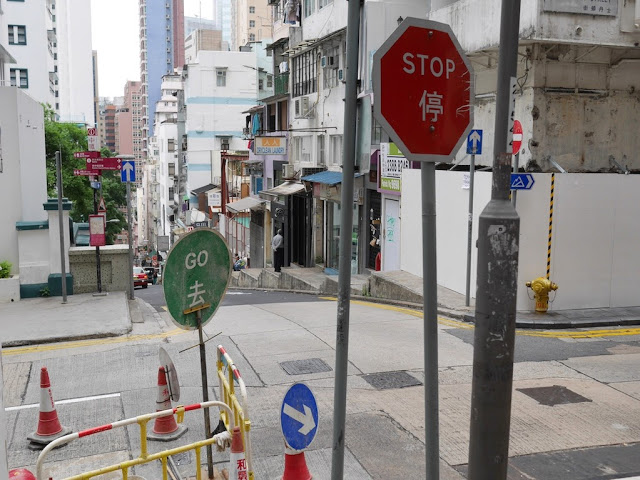Stop and go
« previous post | next post »
Andrew Herron sent in this photograph taken on Hospital Road, Hong Kong Island:
I know that area well, since I lived there during the year 2002-2003 when I was teaching at Hong Kong University. Such scenes are often encountered as one walks or drives up and down the steep, narrow streets. In Hong Kong, construction is a constant.
Practically everyone in Hong Kong knows the English words "stop" and "go" as well as their pairing with red and green lights. So one might hazard that the primary, original language of the sign was the English word "GO". The problem here is that the translation into Chinese qù 去 seems to be incorrect. While "go" is one of the meanings of qù 去 (others include "leave; depart"), it is not idiomatic in this context — for Mandarin speakers. Mandarin speakers would expect that "go" would be translated by the word xíng 行 ("walk; travel; go" and many other meanings).
As testimony to this usage, I cite the following jingle:
hóngdēng tíng, lǜdēng xíng 红灯停, 绿灯行
("red light stop, green light go")
In Mandarin, if you use the word qù 去 as a command, it is almost like telling someone to "get out; scram". Cf. Mandarin "qù nǐ de ba 去你的吧", which is tantamount to saying "go to hell!". A rude Cantonese equivalent would be laan1 hoi1 laa1 躝開啦!
For Mandarin, then, "stop" and "go" are tíng 停 and xíng 行.
This reminds me of a Chinese visitor who stayed with me many years ago. Near my home there was a railroad crossing that was marked by a sign that depicted railway tracks and the word "Xing". He asked me why the sign was telling him to go across when he should stop and be careful.
So far, so good. But what to do with the sign pictured at the top of this post, which — to a Mandarin speaker — has English "go" seemingly mistranslated as Chinese qù 去? Well, this is Hong Kong, and in Hong Kong "stop" and "go" are respectively ting4 停 and heoi3 去.
Here's proof:
[Thanks to Abraham Chan and Fangyi Cheng]


John Rohsenow said,
October 28, 2015 @ 6:11 pm
Not to mention "PED XING", which I have always taken to mean"Foot traffic only".
Mark S said,
October 28, 2015 @ 6:27 pm
@John Rohsenow:
In the UK, road markings are read from top to bottom, as in a book, so I always see that as "XING PED".
brian said,
October 28, 2015 @ 8:38 pm
@Mark: I've always wondered about that. American road councils seem to love writing on their roads, and they love writing in reverse. My apartment car park has "LANE FIRE" written in giant yellow letters all over it.
Furthermore, why "PED XING"? That is an entirely opaque term for someone not completely familiar with English, and even I always read it as "pedzing" at first. Why not "CROSS-WALK" or something that doesn't stretch the imagination so much? Using an "x" in place of "cross" doesn't make sense to me at all, and "pedestrian" is not a word I would ever use, let alone "ped".
Ah, the wonders of street signage and road pavement markings… The USA still hasn't figured out that putting lots of words on their signs means nobody can read them until they're fifteen feet away from them. What's wrong with a sign with a picture of a person stepping onto the road? That can be seen from over 500 metres away, and there's no language barrier. (I have terrible vision: during the day I can see perfectly, but my glasses are so thick that at night the glare makes reading wordy signs difficult from a distance. Contacts work, but I hate them.) My home country of Canada rarely uses words when a picture can do a much better job.
Jenny Chu said,
October 28, 2015 @ 8:53 pm
Hmph. Is the person who said it seems to be incorrect surprised when he goes to Tokyo and finds that the "Chinese" characters are used in different ways? It's Hong Kong. People speak Cantonese here.
I mean – even between British English and American English, which are (mostly) more mutually intelligible than Cantonese and Mandarin, there are differences in signs (e.g. To Let vs. For Rent).
:)
DPickering said,
October 28, 2015 @ 9:57 pm
I've waited at zebra crossings, but never seen one while there.
Bathrobe said,
October 29, 2015 @ 12:16 am
It's Hong Kong. People speak Cantonese here.
True, but even in Hong Kong the written language is mostly Mandarin-based. The use of 去 instead of 行 represents the clear intrusion of spoken Cantonese into the (generally-close-to-Mandarin) written language, which is interesting.
Bathrobe said,
October 29, 2015 @ 12:20 am
@Brian: I'm not sure that CROSS-WALK is that common outside the U.S. I've always called them "pedestrian crossings". "Zebra crossing" is ok but sounds British. "Cross-walk" is understandable but barely even makes it into my passive vocabulary.
Victor Mair said,
October 29, 2015 @ 7:39 am
It took me a while to locate this, but you can find some examples of red and green stop and go signs with writing on them in the Mainland here.
Andrew Herron said,
October 29, 2015 @ 9:51 am
Indeed, I only thought it notable because it was the only instance I saw of this usage in several years living in Hong Kong. Most other apparent "discrepancies" that I ever saw between MSM and Cantonese signage were more preservation of Literary Chinese rather than expressing colloquial Cantonese. For what it's worth, even Hong Kong Cantonese speakers that I've shown it to have thought it was unusual.
Coby Lubliner said,
October 29, 2015 @ 12:22 pm
The US has been slow in adopting pictorial signage. This kind of sign was the norm for a long time before this was adopted, and even now the combined is common.
Rachel said,
October 29, 2015 @ 12:45 pm
This piqued my curiosity, so I tried to find an example of a "go" sign for Taiwan. Nothing turned up in Google image searches. I found this page http://bit.ly/1PWX1mD which appears to be the entirety of the ROC's laws for traffic signs, but I couldn't find any mention of "Go" signs on it.
cs said,
October 29, 2015 @ 1:40 pm
I'm wondering what information is conveyed by the "Go" sign, especially in the bottom picture? At least where I drive, I've never seen such a sign (unless you count the green light of a traffic signal); drivers normally assume that they are free to "go" unless there is a sign or signal saying otherwise.
Victor Mair said,
October 29, 2015 @ 2:26 pm
@cs
Good question!
In Hong Kong, those "stop" and "go" signs are ubiquitous around construction sites where road passage is involved. Because Hong Kong is built on a rocky, hilly / mountainous island, most roads and streets are two narrow lanes. Now, if the construction blocks one of those lanes, it means that traffic in both directions has to use that one lane. Thus the need for those signs which tell the people in the two lanes when they should STOP and when they should GO.
EndlessWaves said,
October 29, 2015 @ 2:54 pm
The sign is double sided with stop on one side and go on the other. The bloke in the first picture stands there and rotates the sign every so often so the queues of traffic in each direction can take turns in going around the obstacle.
Larger road works may have a person with a sign at each end who co-ordinate with each other or motorised rotating signs on a timer. Although I have noticed portable traffic lights becoming more common of late here in the UK, I suppose a sealed solid state light is more reliable and energy efficient than the motorised signs.
Daniel Barkalow said,
October 29, 2015 @ 4:03 pm
I immediately thought of this comic and the next day.
brian said,
October 30, 2015 @ 8:04 am
@brian: In North America, these are usually a double-sided stop sign, with the normal STOP on one side and SLOW with a yellow background on the other. It says SLOW because they really mean it. In my experience, if you drive too fast, they'll start waving the sign at you to get your attention.
@Coby Lubliner: Precisely. Your third example is what I mean.
Victor Mair said,
November 9, 2015 @ 11:26 am
From Mandy Chan:
But 去 and 行 have different semantic meanings in Cantonese. 你去唔去?你行唔行?have different meanings. I dont think Mandarin makes that distinction, or at least not with 去 and 行. The first question is asking whether you want to go; while the second question asks whether you want to walk (physically, as in 行路…there is no "走路" in Cantonese). I think the difference is mainly semantic…I don't know. For some reason, if the sign is translated as "行" , it just doesn't sound right to my ears…
I should also mention the sign has been translated as such since I learned to read…